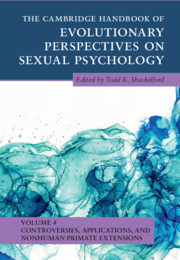Book contents
- The Cambridge Handbook of Evolutionary Perspectives on Sexual Psychology
- The Cambridge Handbook of Evolutionary Perspectives on Sexual Psychology
- Copyright page
- Contents
- Contributors
- Preface
- Part I Controversies and Unresolved Issues
- Part II Applications to Health, Law, and Pornography
- 6 Male Reproductive Health
- 7 Women’s Menstrual Cycles and Ovulation Provide Balanced Estradiol and Progesterone for Fertility and Lifelong Health
- 8 Female Genital Cutting
- 9 Costs of Polygyny
- 10 Male Sexual Disorders
- 11 An Evolutionary Perspective on Female Sexual Concerns and Dysfunctions
- 12 Evolutionary Perspectives on Male Sexual Offending
- 13 Pornography and Male Sexual Psychology
- Part III Nonhuman Primate Sexual Behavior
- Index
- References
9 - Costs of Polygyny
from Part II - Applications to Health, Law, and Pornography
Published online by Cambridge University Press: 30 June 2022
- The Cambridge Handbook of Evolutionary Perspectives on Sexual Psychology
- The Cambridge Handbook of Evolutionary Perspectives on Sexual Psychology
- Copyright page
- Contents
- Contributors
- Preface
- Part I Controversies and Unresolved Issues
- Part II Applications to Health, Law, and Pornography
- 6 Male Reproductive Health
- 7 Women’s Menstrual Cycles and Ovulation Provide Balanced Estradiol and Progesterone for Fertility and Lifelong Health
- 8 Female Genital Cutting
- 9 Costs of Polygyny
- 10 Male Sexual Disorders
- 11 An Evolutionary Perspective on Female Sexual Concerns and Dysfunctions
- 12 Evolutionary Perspectives on Male Sexual Offending
- 13 Pornography and Male Sexual Psychology
- Part III Nonhuman Primate Sexual Behavior
- Index
- References
Summary
Polygyny is common around the world both historically as well as contemporaneously. The evolutionary goals supporting and incentivizing the practice, particularly for men, are clear.However, polygyny does not come without serious economic, social, and political costs for both men and women in the current environment.Like the innate taste for sweetness, polygyny constitutes a case where past drives and goals do not map on well to current environmental circumstances.This chapter begins with some definitional and theoretical issues followed by a discussion of some of the economic, health, and political costs associated with polygyny.Results from recent experimental work on cross-cultural attitudes toward polygyny, involving populations that are nationally representative by sex and by religion,are presented. The chapter concludes with discussion of the some of the theoretical and policy implications resulting from these costs.
- Type
- Chapter
- Information
- Publisher: Cambridge University PressPrint publication year: 2022

